Like most large technology companies, Microsoft also has a mission to make its products more and more accessible to everyone, including users with special needs. In recent years Microsoft has added a lot of accessibility features, currently it has an assortment of built-in accessibility features, making it one of the accessibility systems most practical operations to date.
The accessibility features of Windows 10 are designed to help you see, hear, and use Windows 10. Some of the more important names include; narrator, magnifying glass, high contrast, closed captions, keyboard and mouse. Each of these features includes customization capabilities designed to improve your access to the computer. If you are one of those with special needs or know someone who does, the accessibility features of Windows 10 mentioned below may be of interest.
Windows 10 accessibility features for people with disabilities
Check out these accessibility features in Windows 10 that can significantly improve your user experience or that of a disabled person you know:
- Magnifying glass
- High contrast
- Narrator
- Speech recognition
- Closed captions
- Mouse
- On the screen keyboard
- Eye control.
Let's touch on them briefly.
1) Magnifying glass
With this feature, you can magnify text and other items, such as icons, on your screen without changing the screen resolution of your monitor or laptop. This allows you to play with the size of text or other items on your screen and at the same time keep your monitor or laptop set at its optimal resolution. The magnifying glass can be very useful for anyone who has poor eyesight or has difficulty reading their screen.
To access this functionality, go to the same Ease of Access section in Settings; here is the way: Settings> Ease of access> Magnifier. To use the magnifying glass, activate the "Activate magnifying glass" button.
There are several parameters available in this function which allow you to activate / deactivate the tool, designate what you want to enlarge, and also to invert the colors in the enlarged area. When this feature is enabled, a magnifying glass appears on your screen and you can easily zoom in or out by clicking on the "+" or "-" icon.
Lily: How to increase the font size and enlarge the text in Windows 10.
2) High contrast
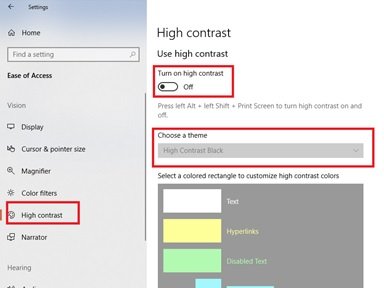
Windows 10 lets you change the overall color scheme to make it easier to view text, images, icons, and application windows. The "High Contrast" function can be amazing for people with visual impairment or color blindness as it can make the items on the screen more distinct and easier to identify.
To select predetermined high contrast themes in Windows 10, go to Settings> Ease of access> High contrast.
3) Narrator
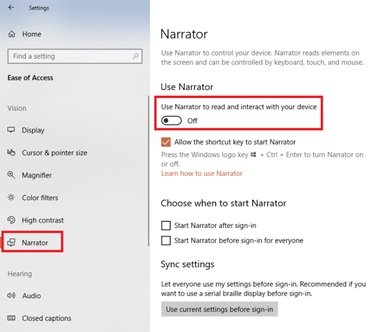
Microsoft named this feature Narrator because of its incredible function. Narrator is a screen reader that can read aloud the text that appears on the screen. It describes events such as error messages, read text as you type, websites, notifications, in-app content and specific parts out loud, so that the user can use the PC without screen. For people struggling with blindness, color blindness or low vision problems, this accessibility feature of Windows 10 can be very useful.
To make your computer speak, get Narrator by going to Settings> Ease of access> Narrator and enable the "Use narrator to read and interact with your device" option.
Lily: How to use Narrator in Windows 10.
4) Speech recognition
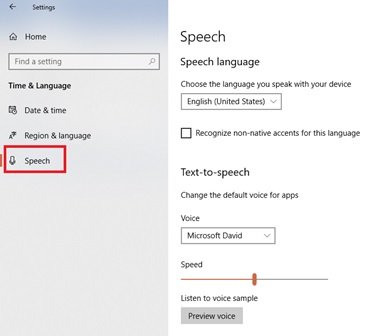
Speech recognition is another gem in the accessibility feature compartment of Windows 10. This feature allows you to control your PC with your voice, including the skill to navigate menus, dictate in almost any application, surf on the Web. In addition, it listens to your spoken words and translates them into actions on the screen.
You can activate this function by opening Settings> Time and language> Speech and scroll down to Dictate text and control your device using only your voice.
Please note: The voice recognition function is only available in English (United States, United Kingdom, Canada, Australia and India), French, German, Japanese, Mandarin (Traditional Chinese and Simplified Chinese) and Spanish.
5) Closed captions
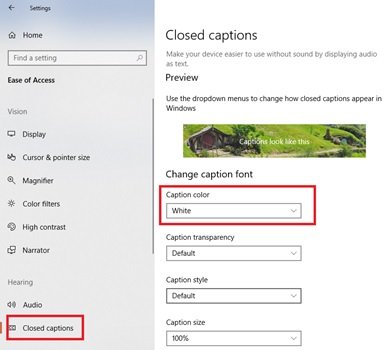
If you're struggling to read blank captions on a video, movie, or TV show, especially on a bright background, the “Closed Caption” feature can be a savior. This feature can help you change the colors and backgrounds of any caption text.
To access the closed captions, go to Settings> Ease of access> Closed captions and change the settings as desired.
You can also customize the transparency, size, style and effects of the legend. A live preview appears at the top of the screen showing each change you make. Note, these settings will be applied to closed captions on all supported local media players.
6) Mouse
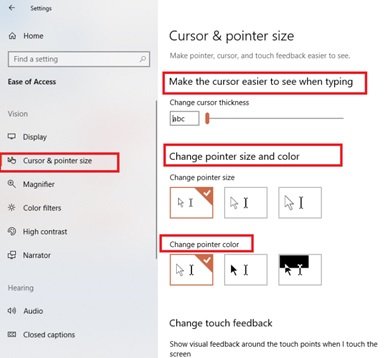
If you find it difficult to locate the mouse pointer on your screen, you can make it more visible with this feature. Yes, you can change the size and color of the mouse pointer that appears on your screen.
To change the appearance of your mouse pointer, go to Settings> Ease of access> Cursor and pointer.
Lily: How to change the color of the mouse pointer to red, solid black, etc. in Windows 10 for better visibility.
7) On-screen keyboard
<img class = "ezlazyload aligncenter size-full wp-image-201146″ alt=”Windows 10 accessibility features” width=”384″ height=”357″ sizes=”(max-width: 384px) 100vw, 384px” ezimgfmt=”rs rscb24 src ng ngcb24 srcset” src=”https://www.thewindowsclub.com/wp-content/uploads/2020/01/On-Screen-Keyboard-settings.jpg” srcset=”https://www.thewindowsclub.com/wp-content/uploads/2020/01/On-Screen-Keyboard-settings.jpg 384w,https://www.thewindowsclub.com/wp-content/uploads/2020/01/On-Screen-Keyboard-settings-150×139.jpg 150w”/>
The on-screen keyboard displays an on-screen visual keyboard; like the normal keyboard, this one has all the standard keys intact. To use this keyboard, you can use your mouse or any other pointing device. This feature offers a variety of customization options for people with special needs or disabilities, making the keyboard much easier and more comfortable to use. Few incredible mini-features of this accessibility tool are:
- Sticky keys – Ideal for those who find it difficult to maintain their finger skills for a long time. These keys allow you to press one key at a time for keyboard shortcut combinations like CTRL + ALT + DELETE.
- Filter keys – This tool will be useful for those who find it difficult to manage their hands on the keyboard. It can check for repeated keystrokes so the user does not need to use the backspace key each time to go back to what he has written.
- Toggle keys – Tells you whether caps lock is enabled or not. It emits a sound each time you press the Num Lock, Scroll Lock or Function Lock keys.
8) Eye control
The eye control function in Windows 10 allows you to access the PC with eye movement. You can use the Eye Control function in Windows 10. Eye Control can be activated by going to Settings> Ease of access> Eye control and select Activate eye control. This will open LaunchPad which is like a control panel from which you can perform various functions such as right click, left click, task view and more.
Windows 10 brings significant innovation to everyone's life, whether you have a disability, a personal addiction or an exclusive work style. With this robust set of built-in accessibility features in Windows 10, Microsoft lets you choose how you interact with your screen, express ideas – ultimately, get your job done.
- Keywords: Accessibility, functionality
